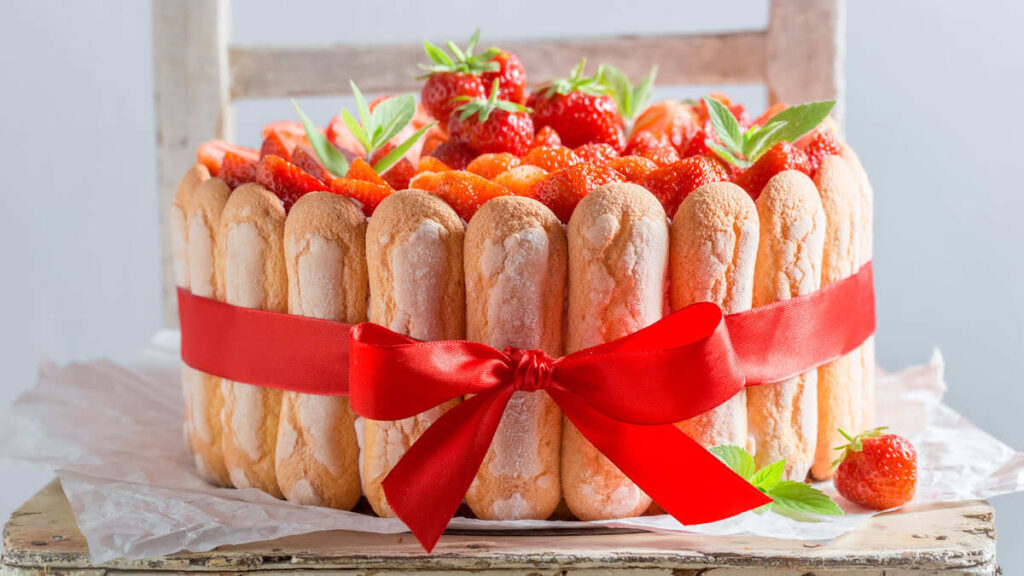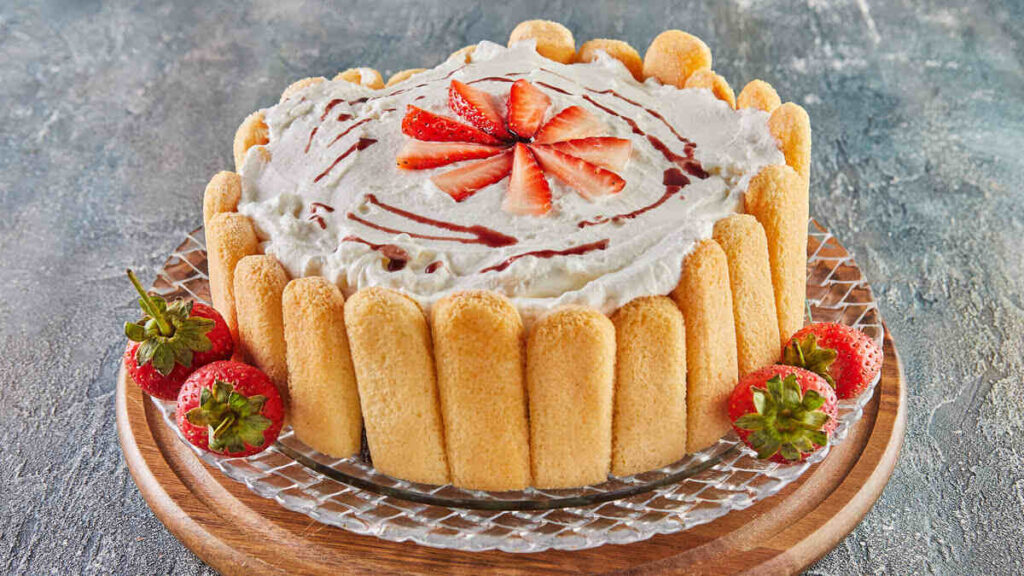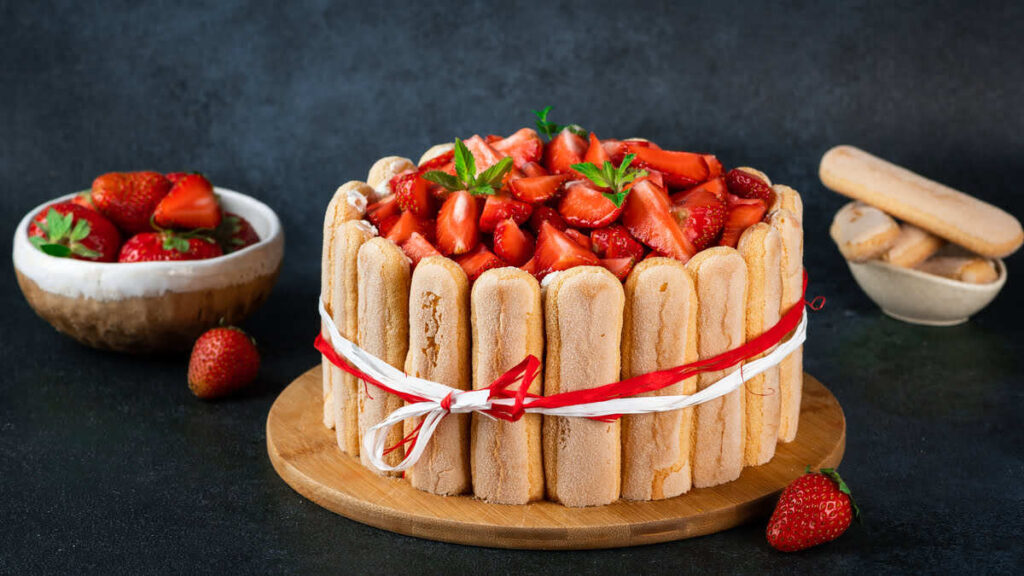
Looking for a No-Bake Dessert Idea? Try a Classic Charlotte Cake

No-bake desserts continue to gain popularity — they are quick to prepare, visually stunning, and perfect for almost any occasion. During the summer months, when the heat makes us reluctant to switch on the oven, light and refreshing sweet treats truly become the stars of home gatherings. One such dessert, impressive both in appearance and taste, is the Charlotte cake.
This classic treat combines the delicate texture of ladyfinger biscuits, the creaminess of the filling, and the freshness of seasonal fruits. If you’re searching for an easy no-bake dessert idea, the Charlotte cake is a must-try — a culinary masterpiece you can create in your own kitchen.
What is a Charlotte Cake?
The Charlotte cake is a timeless dessert celebrated for its elegance and versatility. Its signature feature is the use of ladyfinger biscuits arranged around a soft, creamy filling. Inside the Charlotte cake, you’ll usually find fluffy masses based on whipped cream, mascarpone cheese, or a light custard cream, enriched with fresh seasonal fruits. Interestingly, the dessert requires no baking.
Charlotte Cake | History
The Charlotte cake, also known as Charlotte Russe, has its roots in the early 19th century.
It was created by Marie-Antoine Carême (1784–1833), one of the most renowned French chefs and a pioneer of haute cuisine. Carême crafted this elegant dessert by combining ladyfinger biscuits with Bavarian cream — a light mousse made from custard, gelatine, and whipped cream.
The name “Charlotte” was intended to honour Princess Charlotte of Wales (1796–1817), daughter of King George IV. The “Russe” (“Russian”) part might have referred to Tsar Alexander I (1777–1825), whom Carême also served. In some sources, Carême referred to the dessert as “Charlotte à la Parisienne,” but over time, “Charlotte Russe” became the more widely used name.

In its classic form, the Charlotte cake consists of a mould lined with ladyfingers, filled with Bavarian cream, and chilled until set. The dessert quickly gained popularity among European aristocracy, and its fame eventually spread to other continents. In the United States, especially in New York, simplified versions of Charlotte Russe were sold in bakeries and candy shops in the 1930s, 1940s, and 1950s. These versions typically featured a portion of sponge cake, whipped cream, and a maraschino cherry, served in paper cups with movable bottoms for easy consumption.
Today, Charlotte cakes come in many variations — from traditional to modern interpretations, with additions like fruits, chocolate, or fruit jellies. Regardless of the version, it remains a symbol of elegance and refined taste in the world of desserts.
Different Types of Charlotte Cake
The Charlotte cake has many faces and owes its popularity to its elegance and variety of flavours. The classic version features ladyfinger biscuits encasing a creamy interior, often enriched with fresh fruit. However, over the years, many different versions have emerged, catering to various tastes and occasions.
Charlotte Russe
One of the most famous versions is the Charlotte Russe, filled with Bavarian cream — a light mousse based on whipped cream and gelatine. This dessert is served cold, making it an ideal choice for summer parties.
Charlotte Royale
The impressive Charlotte Royale replaces traditional ladyfingers with slices of Swiss roll. The inside is filled with fruit mousse or cream, and when sliced, it reveals a stunning mosaic. This version is often featured at special occasions, dazzling guests with its taste and appearance.
Fruit Charlotte
Fruit versions of Charlotte cake are very popular, especially during summer. Raspberry Charlotte or Strawberry Charlotte are light desserts combining whipped cream with vibrant fruit mousse. They require no baking and are perfect for celebrations such as communions or summer gatherings.
Chocolate Charlotte
For lovers of bold flavours, there’s Chocolate Charlotte, where the main filling is a chocolate mousse or cream. It is often decorated with fruits like pears or raspberries, which pair beautifully with the chocolate interior.
Charlotte with Fruit Jelly
Modern interpretations often feature a fruit jelly layer that adds extra texture and a burst of flavour. An example is a cranberry-orange jelly version, surrounded by ladyfingers and filled with citrus-infused mascarpone cream.
Charlotte Cake Step-by-Step
Charlotte cake is an excellent idea for an elegant, chilled dessert, praised for its lightness and fruity freshness. Based on a traditional French recipe created in honour of Princess Charlotte, this dessert blends creamy delicacy with intense fruity notes. Below is a recipe that will guide you to creating this impressive cake with ease.

Ingredients:
Ladyfingers:
- 150–200 g ladyfinger biscuits
Fruit Cream:
- 250 g mascarpone cheese
- 200 ml double cream (36% fat)
- 50 g icing sugar
- 3 teaspoons gelatine
- 200 g fresh strawberries
Fruit Mousse:
- 400 g selected fruits (e.g. raspberries, blueberries, strawberries, currants)
- 100 g sugar
- 2 teaspoons gelatine
- 250 ml double cream
Preparation:
Fruit Cream
Dissolve gelatine in about 50 ml of hot water, stirring carefully to achieve a smooth consistency. In a separate bowl, mix mascarpone with icing sugar, then add the chilled double cream. Whip at medium speed until a thick, stable cream forms. Fold in the cleaned, chopped strawberries and the cooled gelatine gently.
Assembling the First Layer
Line a 20 cm springform tin with ladyfingers, placing them vertically around the sides. Pour the prepared fruit cream into the form, filling it up to half the height of the ladyfingers. Place the cake in the freezer for about one hour to allow the layer to set.
Fruit Mousse
Dissolve gelatine in hot water. Heat the selected fruits with sugar over low heat until they release juice and soften slightly. Blend the mixture into a smooth purée — optionally strain it to remove seeds. Mix the cooled purée with the dissolved gelatine thoroughly. Whip the double cream until stiff and gently fold it into the fruit purée.
Assembling the Second Layer
Pour the fruit mousse over the set cream layer. Refrigerate the cake for at least six hours until fully chilled and set.
Decoration
Before serving, decorate the top of the Charlotte cake with fresh or frozen fruits. Optionally, add mint leaves or dust the cake with icing sugar.
Tips for the Perfect Charlotte Cake
Charlotte cake is not only a tasty dessert, but also a real table decoration. To achieve the perfect effect both visually and in terms of taste, it is worth paying attention to a few key aspects when preparing it.
- Prepare the Ladyfingers Carefully:
Ladyfingers form the distinctive “crown” of the Charlotte cake. Trim their bottoms straight so they stand upright easily, and ensure the sugared side faces outward for an elegant look. - Choose the Right Mould:
A 20–22 cm springform tin with a removable bottom or an adjustable cake ring works best. Line the bottom with parchment paper or cling film to help transfer the cake later without damage. - Consistency is Key:
Both the creams and mousses should have the right consistency — too runny and the ladyfingers will soak; too thick and the spreading becomes difficult. Use well-chilled cream and mascarpone, and dissolve gelatine properly to avoid lumps. - Chill Each Layer Properly:
After applying each layer (cream, mousse, or jelly), it’s essential to chill the cake for at least an hour. This ensures a stable, easy-to-slice dessert. - Decorate with Finesse:
Decorate with fresh fruits, mint leaves, or almond flakes. Avoid heavy decorations that could crush the delicate structure. If you use edible flowers, ensure they come from a safe, edible source. - Storage and Serving:
Charlotte cake tastes best well-chilled. Store it in the fridge for no more than 2–3 days to maintain the crisp texture of the ladyfingers. Take it out of the fridge about 15 minutes before serving for the best flavour.
Charlotte | An Extraordinary Dessert for Special Occasions
The Charlotte cake is one of those desserts that combines timeless elegance, simplicity, and exceptional taste. Its roots trace back to legendary culinary masters, and its popularity endures through the years. Delicate ladyfingers, velvety cream, and fresh fruits create a composition that delights both in everyday moments and at special celebrations.
Thanks to its variety of versions and the ability to customise the ingredients, the Charlotte remains a universal and inspiring dessert. Whether you choose the classic Bavarian cream version or opt for a modern fruit mousse interpretation, one thing is certain — this dessert always leaves an impression and becomes the highlight of any table.

If you’re looking for an idea for an impressive no-bake dessert, the Charlotte cake is the perfect choice — stunning in presentation and delicious in taste.



